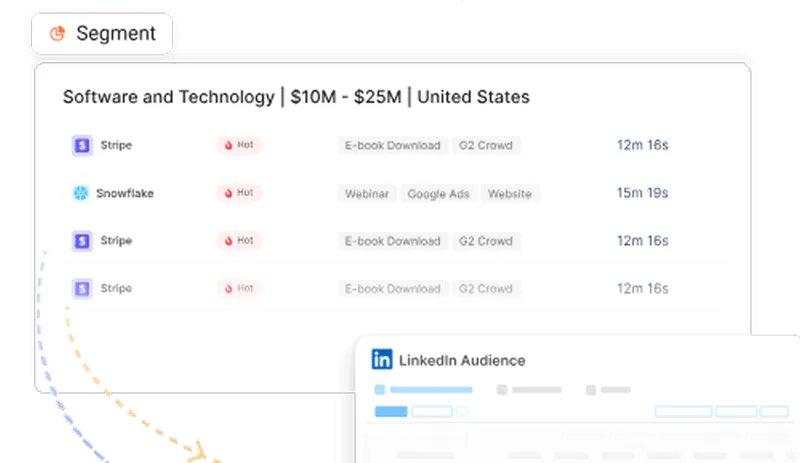The Inbound Marketing Funnel: A Journey from Stranger to Customer
Learn what the inbound marketing funnel is and how to implement it to attract and convert strangers into happy customers. See how Factors supercharges your campaigns.
You’re browsing online trying to find a solution for that leaky faucet in your kitchen.
As you Google “how to fix a leaky faucet” you come across a blog post from a local plumbing company.
The post gives step-by-step instructions for diagnosing the leak and describes the parts you’ll need to pick up from the hardware store.
“This is super helpful!” you think. You check out a few more posts on their site about common plumbing repairs.
A week later, your neighbor asks if you know a good plumber to install a new bathroom sink. The company you stumbled upon pops back in your mind. “I came across ABC Plumbing online. Their articles were really useful, so they seem trustworthy. I’ll send you their website,” you tell your neighbor.
This scenario highlights the power of inbound marketing. With valuable, relevant marketing assets tailored to what potential customers are looking for online, the plumbing company turned a random website visitor into a brand advocate. But why stop there?
Their blog posts and resources also aim to convert website visitors into leads by capturing contact info and nurturing those leads to eventually becoming paying customers.
It’s all part of a methodology called the inbound marketing funnel. Let’s dive into how it works.
What is the Inbound Marketing Funnel?

Remember those old-school sales funnels from Marketing 101?
They depicted a linear sequence starting with many potential prospects who enter the “top of the funnel,” then get whittled down throughout the sales process until only a small portion convert to become customers at the “bottom of the funnel.”
The inbound marketing funnel is quite similar—some may split the funnel further for more clarity or control.
Rather than relying on outbound sales tactics such as cold calling, it uses digital content, ads, and even organic social media marketing to attract prospects, convert them to leads, and then guide them through a sequence aimed at turning them into customers.
This marketing funnel didn’t appear overnight.
The inbound marketing funnel developed as buyers started relying on online research to make purchasing decisions. In fact, a recent TrustRadius showed virtually 100% of B2B buyers prefer to do their own independent research and validate vendor claims, rather than get product information directly from a salesperson.

As buyers changed their habits, marketers had to adapt.
That’s where inbound marketing came into play—creating helpful marketing content for your blog, ads, socials, podcasts, and other channels, designed to meet searchers’ needs, gain their trust, and ultimately convert them into customers.
Let’s walk through the journey a prospect takes through the inbound funnel, and the types of marketing assets they’ll encounter along the way.
Top of the Funnel (TOFU): Attracting Website Visitors

Publishing content on the web functions similar to casting a fishing net.
As people search for topics related to your business, your content “catches” these prospects and brings them back to your site.
Blog posts, social media content, YouTube videos, and other general query-focused content functions well for casting a wide net due to their in-depth educational nature. They attract website visitors by answering common questions and demonstrating expertise related to your products or services.
- For example, a catering company may publish recipe blogs and party food ideas.
- A preschool may create ebooks with advice on preparing a toddler for kindergarten.
- A marketing technology software company may create educational webinars for B2B marketers
This educational content targets “problem phrases” people are likely to search for during early research stages, before they’re even considering vendors—things like “event catering tips” or “getting toddler ready for school.”
This content increases the odds of the prospect discovering your company early on in their journey.
Moving to MOFU: From Visitors into Leads

Continuing from our fishing example: consider that you’ve pulled a net full of fish.
The job isn’t done yet. Before cooking up any dishes, a chef first sorts through the haul–keeping the good quality fish to prepare a meal, throwing out any rotten ones.
This sorting process aims to predict which fish...err, website visitors...demonstrate buying potential versus those unlikely to convert.
Landing pages and forms play a pivotal role here.
Once a website visitor arrives on your site to consume content, they provide behavioral signals, hinting at their readiness to buy. This could be:
- Visiting many pages.
- Downloading a gated asset
- Visiting pricing or feature pages
These conversion points allow you to capture visitor data and score their actions to determine buying potential..
For example, after reading a blog post on toddler kindergarten prep, a parent may click to download the accompanying “Kindergarten Readiness Checklist.” To access the checklist, they fill out a form providing their name and email address.
Now they’re in your sales funnel! You have their contact information and know they’re interested in preparing their child for kindergarten based on the content they engaged with.
The company now customizes follow-up emails with related information on preparing little ones for the classroom. They know sending this relevant content increases the prospect’s likelihood of buying related services like academic evaluation testing, summer “test prep” camps or learning skill development programs. It’s all about nurturing that lead by demonstrating how you can add value.
Guiding Leads to Become Customers
You’ve likely heard the phrase “content is king.” But we mustn't forget that context is queen. Understanding who is engaging with your content allows you to adapt sales messaging to match their needs and interests.
Buyer personas help create this contextual understanding. Common persona profiles may include:
- demographic details like age, gender, profession
- firmographic details like company size, industry, location
- and psychographic details like values, priorities, pain points.
Building buyer personas for your most common customers allows you to tailor content accordingly throughout the sales funnel.
Our preschool may develop personas for first-time parents, growing families with multiple young kids, and dual income power couples focusing heavily on early childhood development.
Bottom of the Funnel (BOFU): Closed Deals

The inbound marketing funnel ultimately aims to guide qualified leads into becoming paying customers. But this final conversion relies on human interaction. Once a lead demonstrates solid buying potential, they get passed to sales teams for closing.
What signals readiness for sales contact?Harvesting enough information to reasonably “know” key details about that lead.
Contact info, demographic and firmographic data, content engagement patterns, plus lead scores predicting their likelihood to buy all guide sales messaging and personalization.
There are many lead scoring models and lead scoring platforms that you can work with to further improve the efficiency of your sales pipelines.
With this head start from marketing, sales representatives don’t waste time pitching unlikely candidates. They can prepare custom pricing packages and product bundles with the knowledge of what that specific persona wants based on their original content preferences.
In our school prep example, leads may experience highly personalized email sequences addressing concerns for young students struggling with change and how they can create structure around new routines.
Once the email sequence is complete and your platform signals lead readiness (either because users opened majority of your emails, or they replied to emails, etc), the sales staff can use captured info and prepare individualized packages for the students.
For instance, a package may include a summer “classroom camp” program to practice school skills targeting those parents who downloaded the Kindergarten Readiness Checklist.
See how it all tied back together?
How to Implement an Inbound Marketing Funnel
Theoretically plotting the marketing funnel is easy. But when marketing is spread across multiple channels, creating a proper funnel can become extremely difficult.
Every platform has its own data analytics, learning curves, and challenges with adoption
For instance, Google Analytics shows website visitor data, LinkedIn analytics shows your social media and advertising data, while Google Ads shows your ad performance.
But what if you could bring all of this together? Enter Factors.

Factors integrates with your Ads, social media platforms, CRMs, search analytics, and more giving you a unified reporting experience.
But that’s just one small part of it.
You have full control over every aspect of the reports, pulling in data from multiple sources and showing them all on a single screen—making it easy to create marketing funnels.

Along with reporting, you can also use Factor’s account intelligence to reveal up to 64% of anonymous accounts engaging with your marketing channels.
This gives your marketing and sales teams accurate information on who they’re targeting, what the personas are, and how they can best approach their account-based marketing strategy.
Factors helps you bring your sales and marketing teams on the same page, giving them complete access to all the required information they can best achieve their goals.
It’s the missing piece to help you execute a cohesive inbound methodology that transforms strangers into delighted customers.
Drive Growth Through the Inbound Marketing Funnel
Now that you know how inbound marketing funnels guide strangers into becoming loyal customers, you can appreciate why this methodology revolutionized growth. So instead of interrupting strangers with annoying sales pitches, you’re delighting people by solving their problems. The inbound funnel transforms throwing spaghetti at the wall and hoping something sticks to methodically transforming prospects into delighted customers.
{{CTA_BANNER}}
Factors can help you take your inbound methodology to the next level.
Integrating data from all your marketing channels into one unified platform, Factors gives you a complete 360-degree view of your prospects' journey. You can easily track engagement across touchpoints, identify behavioral signals, and uncover important details to guide your marketing and sales efforts.
Who wouldn’t want to buy from someone with such precision and care for the customer experience?
Try Factors on your marketing channels for free and experience the impact it can have on your marketing efforts, today!
See how Factors can 2x your ROI
Boost your LinkedIn ROI in no time using data-driven insights


See Factors in action.
Schedule a personalized demo or sign up to get started for free
LinkedIn Marketing Partner
GDPR & SOC2 Type II
.svg)









